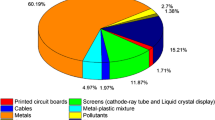Abstract
Disasters can produce a substantial amount of waste that can threaten the capacity of waste management systems. This paper presents a methodology for estimating waste accumulation caused by disasters considering the uncertainty of the timing and scale of disasters that can be used to estimate the return period and the reliability of the disaster waste management system. To estimate the reliability of the system, the first-order second-moment reliability assessment method, in which the reliability index (\(\beta\)) is used to judge the reliability of a system, is applied in this paper. In addition, two case studies illustrate how the methods can be applied to the real world. The reliability index curve of the system developed from sensitivity analysis can provide information for decision-makers in terms of disaster waste clean-up arrangements. The approach developed can be used to analyze the effects of different parameters involved in the waste clean-up system after disasters.








Similar content being viewed by others
References
Abbasi M, El Hanandeh A (2016) Forecasting municipal solid waste generation using artificial intelligence modelling approaches. Waste Manag 56:13–22. https://doi.org/10.1016/j.wasman.2016.05.018
Allen JT, Allen ER (2016) Invited review article: a review of severe thunderstorms in Australia. Atmos Res 178–179:347–366. https://doi.org/10.1016/j.atmosres.2016.03.011
Amirebrahimi S, Rajabifard A, Mendis P, Ngo T (2016) A framework for a microscale flood damage assessment and visualization for a building using BIM–GIS integration. Int J Digit Earth 9(4):363–386
Araghi A, Adamowski J, Jaghargh MR (2016) Detection of trends in days with thunderstorms in Iran over the past five decades. Atmos Res 172–173:174–185. https://doi.org/10.1016/j.atmosres.2015.12.022
Basnayake B, Chiemchaisri C, Visvanathan C (2006) Wastelands: clearing up after the tsunami in Sri Lanka and Thailand. Waste Manag World, pp 31–38 (March–April)
Baycan F (2004) Emergency planning for disaster waste: a proposal based on the experience of the Marmara Earthquake in Turkey. In: 2004 International conference and student competition on post-disaster reconstruction “planning for reconstruction”, Coventry, UK
Brown C, Milke M, Seville E (2011) Disaster waste management: a review article. Waste Manag 31:1085–1098
Chen S, Fang S-S, Lin C-L, Hung H-C (2013) Generation of solid wastes in typhoon disasters and their emergent cleaning and treatment means. J Mater Cycles Waste Manag 15:269–281
Doğan K, Süleyman S (2003) Report: cost and financing of municipal solid waste collection services in Istanbul. Waste Manag Res 21:480–485
FEMA (2007) US FEMA (2007) Public assistance: debris management guide. U.S. Dept. of Homeland Security, Federal Emergency Management Agency, Washington, D.C
Hirayama N, Kawata Y, Suzuki S, Harada K (2009) Estimation procedure for potential quantity of tsunami debris on tsunami earthquake disasters. Proceedings of the Twelfth International Waste Management Landfill CD-ROM
Jingwei S et al (2014) Simulated annealing based hybrid forecast for improving daily municipal solid waste generation prediction. Sci World J. https://doi.org/10.1155/2014/834357
Lai J, Zhang L, Duffield C, Aye L (2013) Engineering reliability analysis in risk management framework: development and application in infrastructure project. Int J Appl Math 43(4):242–249
Lizada JC, Ibabao RA (2013) Building resilience through solid waste management: the case of the Iloilo Province, Central Philippines, pp 698–709
Paulikas MJ (2014) Examining population bias relative to severe thunderstorm hazard reporting trends in the Atlanta, GA metropolitan region. Meteorol Appl. https://doi.org/10.1002/met.1394
Rawtec (2009) Disaster waste management scoping study. South Australia
Swan RC (2000) Debris management planning for the 21st century. Nat Hazards Rev 1:222
Tan ST, Lee CT, Hashim H, Ho WS, Lim JS (2014) Optimal process network for municipal solid waste management in Iskandar Malaysia. J Clean Prod 71:48–58. https://doi.org/10.1016/j.jclepro.2013.12.005
USACE (2006) Depth-damage relationships for structures, contents, and vehicles and content-to-structure value ratios (CSVR) in support of the Donaldsonville to the Gulf Louisiana, feasibility study. Final Draft prepared by Gulf Engineers and Consultants
Xiao J, Xie H, Zhang C (2012) Investigation on building waste and reclaim in Wenchuan earthquake disaster area. Resour Conserv Recycl 61:109–117
Yamanaka M, Toyota N, Hasegawa S, Nonomura A (2013) Estimation method of amount of tsunami disaster wastes during the 2011 off the Pacific coast of Tohoku Earthquake. Int J GEOMATE 4(1):456–461
Acknowledgements
The authors would like to acknowledge the support from the Centre for Disaster Management and Public Safety (CDMPS) and the Department of Infrastructure Engineering at the University of Melbourne.
Author information
Authors and Affiliations
Corresponding author
Appendix
Appendix
In this Appendix, we provide the data we used to make the distributions in Fig. 3 (use data from Table 1) and Fig. 4 (use data from Tables 2 and 3) in the case study. Table 1 illustrates the number of storms in each year from 1967 to 2016 in Victoria and Queensland, respectively. In Tables 2 and 3, we show the data of the frequency analysis respecting the precipitation of storms since it is difficult to put a large quantity of original data in the tables.
Rights and permissions
About this article
Cite this article
Cheng, C., Zhang, L. & Thompson, R.G. Disaster waste clean-up system performance subject to time-dependent disaster waste accumulation. Nat Hazards 91, 717–734 (2018). https://doi.org/10.1007/s11069-017-3151-5
Received:
Accepted:
Published:
Issue Date:
DOI: https://doi.org/10.1007/s11069-017-3151-5




